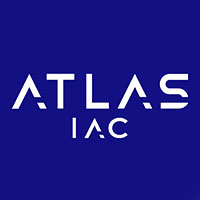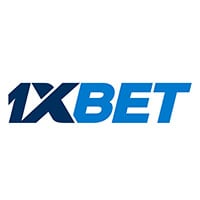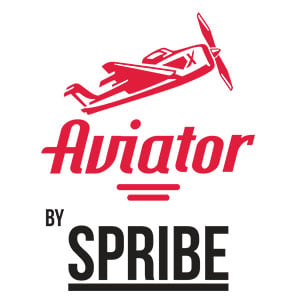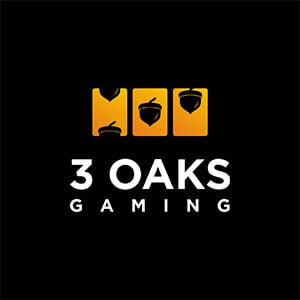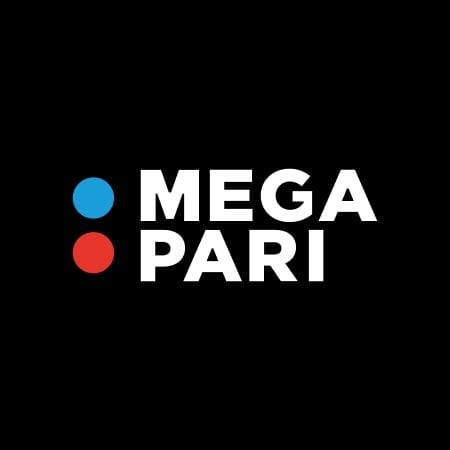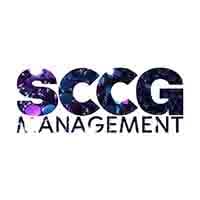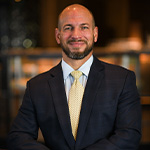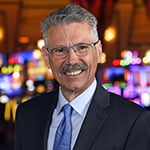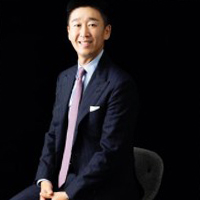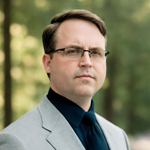Las Vegas was still a desert outpost when Caesars Palace opened its doors on 5 August 1966.
Anyone who has even a passing interest in casinos and Las Vegas understands the pivotal importance of Caesars Palace. With hindsight, its success seems evident, but in so many ways it nearly did not make it.
As the casino resort celebrates its 50 year anniversary as one of the dominant properties on the Las Vegas Strip, we explore the history and importance of Caesars Palace through the prism of the evolution of management theory to understand why this property has stood the test of time, while other similar properties have made their way to the great neon graveyard in the sky.
1960S: HADRIAN’S VILLA
Jay Sarno and Stanley Mallin were the Laurel and Hardy of early-era Las Vegas. Having met at college in Missouri, the pair built and operated the Cabana Hotels in Georgia, California and Texas before turning to Nevada with the idea to build the luxurious Caesars Palace, a 680 room, 14 story tower in Las Vegas. However, Sarno and Mallin had two problems; no land and no money.
The land that the Cabana Palace, or the Desert Palace as it was also known in development, needed was plentiful, but they needed a landowner who would take a bet on two Missouri upstarts with no casino experience and an idea to build something more exciting than another desert-style motel.
Mallin, in his eighth decade and still a resident of Las Vegas, recalls the early days fondly. He says that Kirk Kerkorian (the landowner) and Sarno, both gamblers, hit it off, leading to the deal for the land. They paid the highest price, initially a rental deal with an option to buy. The pair had the idea for Caesars Palace when in Rome buying statues for the Atlanta Cabana. The aim was to build the most luxurious hotel in Las Vegas, and a Rome theme, initially to be called Hadrian’s Villa, instantly appealed.
“There was no bank finance for casinos in those days so the Teamsters lent us all the money. We built it for $10m or $11m, but on opening night finances were tight. Between the staff and owners, we identified the biggest players in Las Vegas and gave them markers. On the night only another $2m from the Teamsters kept us open.”
Mallin and Sarno both had business experience, but all development ideas were their own. “We just wanted to be the best in town. All our energies were spent on raising money, and in one respect that was our failure as the only place we could get staff was from other hotels in town. If we had spent more time on management we would have avoided the problems we had later.”
The party had to stop sometime. The eyes of the Federal Government were closely scrutinising Las Vegas casino ownership and Caesars which, to put it mildly, was not an inconspicuous player put Sarno and Mallin’s position in jeopardy. It transpires that on condition to raise some funds, an investor specified that a particular casino manager, with experience from the Sands, should be hired. Unbeknownst to Sarno and Mallin, that manager was acting for external interests. Federal agents were closing in, so in 1969, only three years after opening Sarno and Mallin, along with the other owners, sold their interest in Caesars to the Perlman Brothers of Miami for $58m. “We captured lightening in a bottle”, Mallin says, reflecting on the times.
Whereas past owners of properties sought anonymity, Sarno was a showman; he ensured spots on Jonny Carson’s TV show, managed to exploit Sinatra’s fall out at the Sands to capture him as resident headliner, and seized international headlines and the national zeitgeist thanks to Evel Knievel’s highly televised fall and misreported 29 day coma after failing to jump Caesars’ fountains on his motorbike.
Looking back to emerging theories of that decade, Harvard academic Theodore Levitt’s now seminal work titled Marketing Myopia makes the case that shaped Las Vegas as we know it. Levitt observed that companies should stop focusing on just selling their products, and instead on meeting customers' needs, which is the real secret to a successful casino resort. For the post-war generation, many of whom had served in the military and were discovering consumerism and suburbia, there was a real need for escapism, luxury and excitement.
Caesars Palace transitioned perceptions of Las Vegas from a desert town for the mob and gamblers into a glamourous escape for all Americans, with Caesars Palace at the iconic centre. A new Las Vegas was born that allowed Kerkorian to go from landlord to casino developer, building the International as the largest hotel in the world, which opened in 1969, and paved the way for casinos to be more than just gambling houses.
Part of Caesars’ early magic was down to the chemistry of Sarno and Mallin, who were very different characters. After selling Caesars Palace, the duo then built Circus Circus a couple of blocks north, but after subsequent financial difficulties eventually went their separate ways. In his later years, Sarno planned his great uncompleted project, Grandissimo, as well as offering classes to emerging casino executives, including a young Steve Wynn. That fact is evident when looking at all Wynn’s properties. There are touches of Caesars Palace, such as the water features and distinctive landscaping, the use of escapist themes and the long driveways taking the customer physically, as well as metaphorically, away from the humdrum of reality into a new world of escapism.
Mallin plays down his and Sarno’s impact. “It was all about the property. Caesars Palace sold itself.” But in truth, the Sarno-Mallin period of ownership defined casino development and national perceptions of Las Vegas, almost by accident, in creating Caesars Palace. They established a brand that entered public consciousness that has lasted five decades.

1970S: IT’S A CAESARS WORLD
Stuart and Cliff Perlman owned Florida based Lum’s, famous for beer-soaked hot dogs.
However, belying this simple business concept, the Perlman brothers were sharp thinkers, expanding a single stall to a national franchised business before exiting Lum’s to run a newly formed business called Caesars World, named after its most important asset.
Under the Perlmans’ guidance, Caesars Palace expanded by adding the Centurion Tower in 1970, The Roman Tower was extended in 1974 and The Forum Tower, with the now famous “Rain Man Suites” opened in 1979.
Fred Kolman came to Caesars Palace in the 1970s, ending up as a long-standing member of staff.
“Caesars meant history and legacy. During this period there was a sense of luxury throughout, from the turquoise lighting outside, to Louis Prima in the lounge and Sinatra in the showroom. The biggest stars played at Caesars Palace and the management knew that they had to be ahead of the curve as others always wanted to challenge Caesars. We had the best staff and the best customers. Everyone was classy.”
The 1970s was a key time for Caesars and Las Vegas. In 1970, Las Vegas had 6.7m visitors and average hotel occupancy stood at 70%. By 1979 visitation had grown to 11.7m visitors, occupancy levels were 86.8%. In addition to increased visitors, gaming revenue grew massively. $369m was bet on the Strip in 1970, by the close of the decade this had risen to $1.4bn. Las Vegas really was the global capital of gaming and much of this was down to the Perlmans expanding Caesars Palace to be the dominant player, increasing the market size, and by extension its market share.
It was also in the 1970s that strategic management became a dominant business philosophy, advocated by the likes of Peter Drucker and Igor Ansnoff. The Perlmans, based on their hot dog business, understood the concepts within profit impact of marketing strategies, which centred around theories that the greater a company’s market share, the greater their share of industry profit was likely to be. The Perlmans understood that Caesars Palace was a national brand that had meaning and could be rolled out, like their hot dog stalls. Secondly, Caesars was a cash-cow and provided the base for both expansion and diversification that would suit this management philosophy.
While not creative visionaries in the Sarno mould, the Perlmans’ major contribution to the Caesars Palace story was they knew how to exploit the brand to maximise revenues and expand the company, not just in the Las Vegas but beyond. They acquired hotels in towns as diverse as Caesars Brookdale in Texas, Caesars Tahoe, and to New Jersey in what was to become Caesars Boardwalk Regency in Atlantic City. It was an investigation into the latter which uncovered allegedly unsavoury business dealings, leading to Caesars World (a public company) buying the Perlmans’ interest in 1980 for $98m.
1980S: THE WRONG COAST − THE ATLANTIC CITY DECADE
In the early 1980s Caesars Palace retained its place as the dominant property in Las Vegas, and its branded sibling was a shining star in the Atlantic City market, where gaming revenues consistently outstripped those of Las Vegas. Between 1982-1994, Henry Gluck was the driving force behind Caesars World, shoring up revenues, cutting costs, making efficiencies and maximising profits at a time when the bottom line reality did not meet top line expectations. In 1981 the corporate entity lost $21m, however by 1984 it produced $32m in profits.
As a large corporate entity there were several hostile financial manoeuvres, including one by Donald Trump which Gluck defended. Caesars World continued to diversify in the gaming sphere as per the PIMS maxim, operating casinos on cruises and other jurisdictions. The mothership, Caesars Palace, ticked over.
Gluck, unlike many of the gaming executives of the time, was an outsider. Already a highly successful businessman when he joined Caesars World, his expertise was not in gaming, hospitality or fulfilling the wishes of customers. He was a businessman and eschewed the high volatility of Caesars Palace (which suffered from several bad creditors at this time) and sought to position the property squarely for the middle classes.
With Frank Sinatra now on the books as director of entertainment, Caesars became the home to his band of aging swingers and crooners, signed up for package deals in multiple Caesars properties. It was firmly established as the garish icon of 1980s Las Vegas, featuring in movies from the George Burns vehicle Oh God, You Devil to Rain Man, where Dustin Hoffman dances at the duplex suites of the Forum Tower. Caesars Palace hosted sporting events including The Davis Cup, boxing fights and two Grand Prix. Robbie Knievel succeed where his father failed and finally cleared those fountains.
Caesars World also instituted a number of innovative attractions at this time to lure customers, including the OmniMax Movie Theatre, The Atari Adventure centre and a live ice skating tournament, but none of these lasted the test of time.
As a brand, Caesars in the 1980s was a symbol of Las Vegas – a kitschy pastiche of American excess, a something for everyone. As a rival casino manager commented in 1985; “They probably do what Las Vegas was created for better than any property in Las Vegas. That is, getting a mix of everyone, from the extremely high roller to the low-end player.”
It was clear that all Caesars' eyes were on Atlantic City, as building a new parking garage was the only riposte to Steve Wynn opening The Mirage in the closing months of 1989. To great fanfare, The Mirage immediately broke all occupation and gaming revenue records.
Caesar was no longer the emperor of Las Vegas, Wynn was.

1990S: PUNCHING FROM A CORNER
There is little evidence that Gluck, Lanni and the Executives at Caesars World were prepared for the explosion in competition and visitation that was about to happen in Las Vegas, ironically by those inspired and mentored by Sarno and Mallin a quarter of a century earlier.
Phase one was to the north in 1989, Wynn’s Mirage was the first fully-formed integrated casino resort, with Siegfried and Roy’s white tigers, an exploding volcano and a new, modern, luxury room offering that directly targeted Caesars' VIP guests. 1990 saw the Excalibur, aimed at the low to mid-market, open with 4,000 rooms which made it the largest hotel in the world, only to be outdone in 1993 when the 5,500 room MGM Grand opened. After Excalibur, Circus Circus enterprises raised their game with the iconic Luxor, initially an attempt to move into the lucrative VIP segment. It is worth noting that Bill Bennett, CEO of Circus Circus Enterprises, operated one of the highest profit to revenue models in Vegas but the initial foray into the VIP market was not as successful; a greater legacy is that dollar for dollar, Excalibur has proved one of Las Vegas’ most successful properties.
It is the most basic of economic principles that competition leads to innovation but not all could keep up, and the old boys began to slip away. The Riviera, the Sands, the Sahara, the Desert Inn, the Dunes and Flamingo were also challenged. Some made it, others did not. Yet it was Caesars Palace that had the most to lose, and like the former boxer and Caesars host Joe Louis, fight it did, throwing punches left and right, with some hitting and others missing badly.
What Caesars Palace had as a competitive advantage to those other properties was a globally recognisable brand, but behind the columns and statues the experience was unrecognisable from the glory days. The corporate decades had eroded the extravagance, eyes were now firmly focused on managing both volatility and the bottom line. From a management perspective, under Gluck there was no overarching strategy other than to run an efficient business to maximise profits. The view was to give the customer more, rather than better; quantity was valued above quality.
On one hand, Gluck inspired Caesars World to invest $100m in a shopping mall, featuring a blend of very high brands, but also affordable retail. This was initially much derided, but proved to be a lasting legacy for Caesars Palace. Having been expanded several times, it is still one of the most successful malls in the world today and has turned Las Vegas into one of the retail capitals of the USA. The Forum also led to the introduction of the celebrity chef to Las Vegas, with Wolfgang Puck to be the first of dozens of chefs to launch offerings in the town.
On the flipside, Caesars Palace continued to host sporting matches, including boxing and tennis, but the larger bouts moved to MGM’s new arena. With many older stars moving into retirement, the entertainment offering was bland, with the nadir being the hosting of WWF Wrestlemania; seeing toga-wearing wrestlers simulate fighting moves where Sinatra once strode was a new low.
In the early 1990s Caesars held its own, just.
It was around this time that a group of Harvard academics wrote a paper called Putting The Service Profit Chain To Work, which formed the basis of what we know today as relationship marketing. The authors, including a young professor called Gary Loveman, hypothesised that only customer loyalty drives profitability and growth, and customer satisfaction drives loyalty. In other words, quality beats quantity.
Halfway through the decade, the corporate hospitality world re-engaged with Las Vegas once again, seeing the profitability of gaming, as Mirage Resorts, MGM and Circus Circus demonstrated to the market. Other larger companies, also believing the maxim that expansion holds benefits, eyed the iconic Caesars brand and portfolio, and in July 1995 the ITT Sheraton Corporation beat out other rivals and acquired Caesars World for $1.7bn. Gluck retired again shortly after.
With customers defecting to newer hotels, those managing Caesars in the first half of the 1990s sought to build the business by offering more to the customers in order to capture their loyalty.
This was necessary, as by the decade’s end it was not just the Mirage, MGM and Luxor that had their eyes on Caesars’ customers, but also the Mandalay Bay, the new Aladdin, The Bellagio, Monte Carlo, Paris, New York New York and Sheldon Adelson’s convention focused Venetian. Vegas was undergoing a generational expansion.
As a strategy to compete, Caesars sought to challenge with size, scale and range of offering. Internally, Park Place (Caesars' new parent company) built Paris in Las Vegas, which was positioned as a higher end property in the portfolio but with little discernible differentiation other than theme, which shows a valuable insight into the thinking of this era.
Drivers for competitive advantage, as we now can assess, are very few. In the period when it seemed that each quarter brought a new Strip opening or two, the prevailing thinking was that there was an under-supply to the market and differentiation strategies such as theme and architecture were sufficient to capture market share. The dynamic that played out was that theme alone proved to be not enough; it allowed for successful differentiation in marketing, but not much else. What became more evident in this period was that the theme became a brand, but it was the experience that determined customer loyalty and retention. As experiences, such as restaurants, gaming and entertainment became more generic, the competitive drivers diminished.
Upstairs in the corporate boardroom, all was not roses either. Terry Lanni had left the company in the wake of ITTs takeover. In the quest for ever increasing profits, once manageable businesses had led to highly diversified sprawling conglomerates which were becoming increasingly difficult to manage. ITT held diverse interests ranging from insurance companies to hotels and casinos, which made it attractive to suitors that wanted to acquire specific industries, with the new thinking, opposite to PIMS, that refined business processes management theories dedicated to specific sector growth could lead to greater efficiencies and profits. One of those was to become hospitality giant, Starwood, which acquired ITT in 1997.
Shortly after this takeover Starwood, which focused on hotels rather than casinos, exited the volatile and regulated Caesars World gaming assets and interests to Park Place, ironically a gaming spin-off from the over-expanded Hilton, which had faced similar boardroom pressure to separate. By then, Caesars World included not just Caesars Palaces in Las Vegas and Atlantic City, but gaming interests across the USA, Canada and many international locations.
Bill Hornbuckle succeeded Lanni at Caesars Palace and was responsible for the expansion of the Palace Tower, including over 1,000 further rooms, conference facilities, and Caesars’ Magical Empire, a dinner show with close up and stage illusions for the family.
By the mid-1990s Las Vegas was looking at another type of customer. No longer an adult Disneyland, it was a place for entire families to spend their vacation. Treasure Island, Excalibur and MGM had set the scene for this new market, and Caesars sought to fit the competitive set by building Atlantis in 3D at the Forum Shops. This was intended to complement the other family attractions on offer which made Caesars Palace a must-see for the new class of visitor. Vegas was no longer attracting just gamblers, but actual tourists coming to see the spectacle of fountains, wild animals, a reimagined circus in Cirque Du Soleil and even an Eiffel Tower.
Leadership of the gaming industry was professionalising as outsiders from the business world became insiders, bringing best practice and innovation. As the Clinton decade matured, there was economic growth and consumer confidence across the USA. Las Vegas was seeing increased convention business and tourists; in 1997 visitation exceeded 30m compared to 20m a decade before, and gaming revenues broke $6bn for the first time. Could it get better for Las Vegas? Of course it could.
Each passing year broke new records, as the century closed in 1999 34 million visitors came to Las Vegas spending over $7bn on gaming. Caesars Palace stood as an icon on the Las Vegas Strip, sandwiched between Wynn’s exploding volcano at The Mirage and his Bellagio; the first megaresort of 3,000 rooms developed exclusively for the high end customer that had once been Caesars’ preserve.
Caesars Palace had been reinvented from the adult’s playground of Sarno’s dreams and instead stood as a uniquely branded hubbub of gamblers, families, actors, chefs, shoppers and tourists.
The brand had moved from elegant, escapist luxury to wrestlers in togas, with aging singers, magicians and rows of seniors popping quarters into slot machines. It was a theme park casino, or as one former executive at Caesars that asked not to be named commented at the time: “Caesars was a zoo! Managing volatility is the key to successful casino management, and under the corporate ownership at this time Caesars got it wrong when they tried to manage that volatility. They lost their high-end players to the Mirage and the Bellagio and struggled to get them back.”
Marketing theories were changing and moving away from the one size fits all, to the beginning of segmentation and market orientation.
Again as the decade closed, Caesars Palace proved it had been reinvented for 1990s Las Vegas, but was no longer representative of the brand above the door. Caesars Palace was better than what it had become.

2000-2005: REINVENTION
In summer 2000 Arthur Goldberg, the aggressive corporate raider and company builder that had wrestled casinos from both Hilton and Starwood, beating and bullying both Donald Trump and Steve Wynn to build a global gaming business with Caesars Palace at the heart, died suddenly. He was 58.
At Park Place, without Goldberg’s leadership, there was a revolving door of property presidents and unfulfilled announcements about hotel expansions and new towers. However, in 2001 Caesars Palace took a bold step by announcing the development of a new concert arena in place of the Circus Maximus, and the closure of some of the kitschy aspects of the property, including The Magical Empire.
The management team, led by Mark Juliano, George Markantonis and John Unwin developed a segmented strategy seeking to appeal not to the everyman tourist that had been the riposte to the Mirage, but to focus on a particular type of customer – the profitable customer that was once the core of Caesars Palace’s success.
In 2003, the much anticipated Colosseum opened with Celine Dion supported by Elton John as resident headliners, a far cry from the stereotypical Vegas entertainers playing their swansongs. By the time her first residency finished in 2007, Celine had generated over $400m in ticket sales; the show was the hottest ticket in town as over three million wealthy guests, paying over $120 per ticket, flocked to Caesars from across the world to see a top entertainer in a spectacular setting. Every show was a sell-out.
This was part of a phased reinvention of Caesars Palace, acknowledging the brand still had resonance. The high roller patrons that had left Caesars to play elsewhere now had a reason to return.
Caesars Palace cemented the return to the high end by announcing the construction of the Augustus Tower, with rooms, a spa and restaurants to match the finest offering in town. Juliano, Markantonis and Unwin, who have subsequently formed successful careers as innovative and reforming casino managers at other properties, began to modernise the traditional operations by synthesising customer centric strategic marketing concepts into the main body of the business. From the inside it was a mission to elevate the property and compete with the finest, and from an external viewpoint, the casino became home to leading restaurants and chefs, including Rao’s from New York, Bobby Flay’s Mesa Grill and Bradley Ogden which all opened off the casino floor, not in the mall. Relationship-based hosts were brought in to manage customers as Caesars was able to offer aligned entertainment experiences to their high-end patrons, including access to Pure nightclub which immediately became the number one nightclub in the world (and fuelled the nightlife expansion in Las Vegas). It was the place where the hottest stars and “it” celebrity icons, such as Paris Hilton and Britney Spears, came to party.
Like Steve Wynn had done with Sinatra at the Golden Nugget 20 years earlier, Caesars had again sought to align with external brands and personalities to validate its position as a leader in the market. It worked, and Caesars was back as a luxury property and the party centre in the entertainment capital.
Elsewhere in 2003, Dr Gary Loveman, co-author of Putting the Service Profit Chain to Work, back in the 1990s, penned another paper for the Harvard Business Review called Diamonds in the Data Mine observing his recent successes in customer tracking. Loveman had moved from being a theoretical academic at Harvard to taking his experiments to the real world at Harrah’s, the Memphis based casino company, in 1998.
Harrah’s had launched a national loyalty programme where points could be accumulated in multiple locations.
“First, we use database marketing and decision-science-based analytical tools to widen the gap between us and casino operators who base their customer incentives more on intuition than evidence. Second, we deliver the great service that consumers demand. In short, we’ve come out on top in the casino wars by mining our customer data deeply, running marketing experiments, and using the results to develop and implement finely tuned marketing and service-delivery strategies that keep our customers coming back,” wrote Loveman.
Harrah’s was a pioneer of what we now call “big data”, taking all aspects of customer data, analysing and identifying behaviour and reacting to it – at the same time offering incentives for increased spend, and these incentives came both in the way of increased service benefits and money saving offers. Of course these did not appeal to high volatility players, but did to the millions of middle American gamers who now had access to gaming thanks to the proliferation of regional casinos.
Harrah’s had built and bought a portfolio of regional casinos and brands, including Horseshoe and WSOP, but were lacking a signature property for their most valuable customers’ high-end play. They acquired the Rio, but they found the largest regional players were still resistant to playing at that or any other properties in their portfolio in Las Vegas. Harrah’s noted that their product was compelling from a marketing point of view, but lacked the aspirational element.
Back in the corporate world, businesses were once again consolidating to find economies of scale and buy market share. Kirk Kerkorian and MGM had made waves when acquiring Steve Wynn’s Mirage Resorts in 2000 for $6.4bn, leaving the modern day Sarno without a home, but with a large amount of cash, ownership of the dilapidated Desert Inn on the unfashionable north side of the Strip and a plan to build what is now The Wynn and Encore properties. The corporate raider Kerkorian again took advantage of management discord and was able to acquire Mandalay Resorts for $7.9bn in 2005. MGM was firmly in control of the west side of the Strip, with Caesars an island.
It what seemed like a perfect match, on the eve of her 40th birthday in 2005, Caesars Palace was part of the $10.4bn acquisition of Park Place, now renamed Caesars Entertainment, by Harrah’s in the largest casino deal in history. Through expansion, contraction and expansion again, Caesars Palace was at the forefront of the world’s largest gaming company with a global footprint.
It was a winning scenario; Caesars Palace received an injection of cash, access to the Total Rewards database and the ability to be at the forefront of the big data revolution. Harrah’s had acquired the legendary Caesars Palace as the flagship and all prepared for a successful future.
2005-2015: THE IDES OF MARCH?
As Julius Caesar will attest, the real danger lies when you least expect it.
Midway through the decade, Caesars Palace was the jewel in the crown of Harrah’s globally diversified portfolio. The Augustus Tower, a new 27 storey high-roller tower was opened featuring a restaurant by acclaimed chef Guy Savoy and an award leading spa. A further tower, Octavius, was planned.
This new company, with strong cash flows, iconic brands, the WSOP, a diversified global base and the revolutionary Total Rewards database was widely coveted. It moved into private ownership as private equity giants Apollo and TPG acquired the company for $17.1bn in 2008 in a leveraged buyout.
The deal was good but the timing was fatal. Leveraged buyouts were the synthesis of so-called efficient financing and strong operating businesses with potential for growth, where finance houses used large amount of debt to achieve high investment returns on equity. As long as the debt payments could be met from the large diversified database of customers across America, the new structure would work well. Unfortunately, as ink was drying on the deal, the global economic crisis deepened and Harrah’s, now renamed as Caesars Entertainment, faced severe corporate challenges.
Firstly, discretionary spending in the USA was reduced, meaning less spent on trips to Las Vegas and in casinos on a regional basis; in 2007 average gaming spend per customer was $555, but by 2010 this was $446. Secondly, there was no room to manage the huge debt placed on the company after the acquisition, and much of this was before the massive stimulus in rate management. Thirdly, over 15,000 of additional room inventory came online in Las Vegas just as demand fell. What was to sustain the other Las Vegas operators during this crisis wasn't available to Caesars as it did not have exposure to the recently liberalised market of Macau.
The financial manoeuvrings required to manage the massive debt let to a corporate finance case study that has still to be written, and as we all know, part of the company is in a contested bankruptcy process, which is still ongoing at time of writing. It was inevitable that throughout the portfolio cost efficiencies were made, but in Las Vegas, Caesars Palace remained the main beneficiary of investment as Caesars Entertainment knew the value of the flagship.
In 2010, George Day and Christine Moorman looked at organisational strategies. Much like Levitt a generation earlier, they defined organisations as either Outside- In or Inside-Out businesses. Most gaming and casino companies are Inside-Out, with management or even a single individual shaping the organisational strategy. However under Loveman’s big data approach, Caesars Entertainment became the poster boy for the Outside-In approach, with millions of transactions analysed and fed into the decision making process. What this means in reality was that Ceasars’ executives were able to capture vast amounts of customer data and develop a product that reflected the customer based on existing behaviours.
Under the steady hand of Gary Selesner, who was a long-serving Harrah’s executive, this scientific method flourished, despite the financial soap opera in its name, and Caesars Palace continued to thrive. Selesner’s tenure began in 2005, he is now the longest serving president in the property’s history, but he has faced a series of challenges.
Not only was the parent company facing severe financial pressure and a changing visitor profile, but the Las Vegas market faced another generation of new competition, with the opening of the Wynn and Encore, Palazzo, Aria and The Cosmopolitan, which was led by John Unwin and other veterans of the Caesars Palace reinvention.
Again, Caesars expanded the entertainment offering, with Matt Goss having a residency in Cleopatra’s barge as well as reprising Celine Dion’s headlining residency at Caesars Palace. Also following on from the previous generation’s successful strategy, Caesars Palace became home to Gordon Ramsey, replacing Bradley Ogden, and bringing Old Homestead to Las Vegas, seeking to replicate the success of Rao’s.
But once again the key driver for renewal of the property was not Loveman’s database or Selesner’s tweaking of the formula, it was the brand that Sarno and Mallin created when today’s executives were still at school.
Despite increased competition, what property epitomises luxury escapism for the 21st century bachelor party more than Caesars Palace?
The Hangover’s tale of four guys retracing their steps on a wild night out struck a chord with a depressed America. Without any established stars and costing only $35m to make, the movie generated nearly $500m in revenue, and the star of the movie was Caesars Palace, which re-entered the public’s consciousness, just as Evel Knievel had 40 years before. Thanks to Hollywood, Mike Tyson and a tiger, Caesars Palace again meant escape and excess for a new generation.
The new buffet won awards as the best in town, and is the highest grossing restaurant in North America with revenues over $50m. The queue is out the door from open to closing. In 2016 the original tower was fully renovated as the Julius Tower completing a full renovation of the nearly 4,000 rooms that are modern Caesars Palace. Omnia opened as the new nightclub in place of Pure, with Calvin Harris DJ’ing there weekly, alongside some of the world’s leading talent. Justin Bieber celebrated his 21st Birthday in the Nobu Tower and Mariah Carey joined Celine Dion as a resident headliner; a range of new entertainment is scheduled for the 50th year. A senior executive told me that for the first time in a long time: “The coolness factor is back for a new generation.”
CONCLUSION: THE DEATH OF JULIUS AND THE RISE OF AUGUSTUS?
Looking at Caesars Palace today, it has it all. A classic full range casino, great restaurants, a top nightclub, a world class shopping mall, the world’s finest entertainers in one of the best venues anywhere in the USA, thousands of rooms to meet all tastes and budgets, but at the core of it all is the iconic brand, once again reinvented for a new generation of customers. Caesars Palace is Las Vegas.
For the outsider, Caesars Palace has defined Las Vegas in every age, but to the insider it is the story of post-war American business theory in practice. The outsider sees the glamour of Sinatra, the sporting events, magicians, wrestling and shopping of the 1990s. It sees Paris Hilton partying, and Celine Dion’s dominating performances. However, for those in business it is a story of bold innovators taking risks with a radical idea, losing control as external factors and competition forced its way in. Of new owners expanding the offering and launching brand exploitation leading to overstretch. It is a tale of competitive threats, of imitation and innovation, and eventually feeling comfortable again with brand renewal, repositioning the offering for a new generation of customers, only to be undone by the great recession of 2007.
Neither Las Vegas or Caesars Palace are the same places today as they were in 1966. The radical genius of Sarno and Mallin is timeless, as is the desire of others to expand and conquer. In the case of Caesars Palace, each owner or manager has added something that enabled sustainable success, but it took the generation of hospitality leaders in the 2000s to reimagine what it meant to be a Caesar for the 21st Century. It was their success in creating the “son of Caesar”, an Augustus to Julius, that allowed this property to reassert its rightful place in Las Vegas, with confidence and determination. With a strategic focus on appealing to escapism and aspiration, rather than wants and needs, the brand and experience are now aligned.
After five turbulent and eventful decades, of champagne and hangovers, once again all in town can declare with a single voice; “Hail Caesar, Emperor of Las Vegas. You came, you saw, you conquered.”













